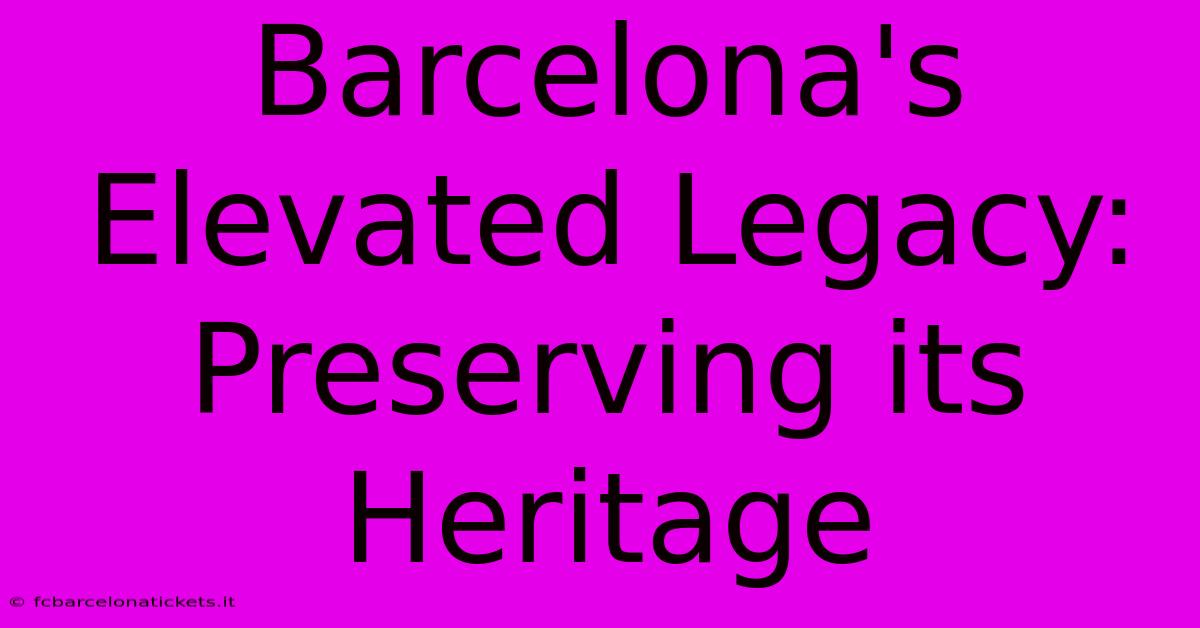Barcelona's Elevated Legacy: Preserving Its Heritage

Table of Contents
Barcelona's Elevated Legacy: Preserving its Heritage
Barcelona, a city pulsating with modern energy, simultaneously cherishes a rich and layered history. From the Roman ruins whispering tales of the past to the breathtaking Gaudi masterpieces defining its architectural landscape, Barcelona's heritage is a vital part of its identity. But preserving this legacy requires a multifaceted approach, balancing the demands of a thriving metropolis with the imperative to protect its cultural treasures. This article delves into the challenges and triumphs of safeguarding Barcelona's elevated heritage for future generations.
The Enduring Legacy of Antoni Gaudí
No discussion of Barcelona's heritage is complete without acknowledging the profound impact of Antoni Gaudí. His fantastical creations, including the Sagrada Família, Park Güell, and Casa Batlló, are not merely buildings; they are artistic statements that captivate millions of visitors annually. Preserving Gaudí's legacy necessitates meticulous maintenance and restoration efforts, requiring specialized expertise and significant financial investment. The ongoing work on the Sagrada Família, for instance, highlights the long-term commitment required to ensure these architectural wonders endure. The city’s commitment to Gaudí tourism also presents a challenge: managing the influx of visitors while protecting the sites from overuse and deterioration.
Beyond Gaudí: A Diverse Architectural Heritage
Barcelona's architectural heritage extends far beyond Gaudí. The Gothic Quarter, with its labyrinthine streets and medieval buildings, offers a glimpse into the city's earlier history. The preservation of the Gothic Quarter involves careful urban planning, balancing the needs of residents and businesses with the preservation of its historic fabric. This includes initiatives to protect against over-tourism, ensuring the preservation of the area’s unique charm and atmosphere. Furthermore, the city boasts a diverse range of architectural styles, from the modernist works of other prominent Catalan architects to examples of Renaissance, Baroque, and Art Nouveau architecture. Protecting this diverse architectural tapestry requires a comprehensive approach that considers the unique features of each era and style.
The Role of Museums and Cultural Institutions
Barcelona's museums play a crucial role in safeguarding and showcasing its heritage. The Museu Picasso, for example, houses a significant collection of the artist's works, providing invaluable insight into his life and creative evolution. Supporting these institutions is vital, not only through funding but also through initiatives that encourage wider access and engagement with the collections. Furthermore, the city’s numerous archives and libraries hold vast collections of historical documents, maps, and photographs that contribute significantly to our understanding of Barcelona's past. Digitalization projects are playing an increasingly important role in preserving these fragile materials and making them accessible to a broader audience.
Balancing Modernization with Preservation
The challenge of preserving Barcelona's heritage lies in striking a balance between modernization and the protection of its historical fabric. The city's continuous growth and development necessitates careful urban planning that considers the impact on its historical landmarks and neighborhoods. Sustainable urban development initiatives, focused on preserving historical areas while creating modern infrastructure, are crucial in ensuring the city’s future doesn't come at the expense of its past. This includes creating pedestrianized zones, improving public transportation, and investing in renewable energy sources.
Community Engagement: A Shared Responsibility
The preservation of Barcelona's heritage is not solely the responsibility of the city council or cultural institutions. It requires the active participation of the community. Encouraging civic engagement through educational programs, public awareness campaigns, and volunteer initiatives is critical in fostering a sense of ownership and responsibility for the city's past. This can include initiatives involving local residents in restoration projects or promoting the understanding and appreciation of Barcelona's history. Furthermore, responsible tourism practices play a crucial role, encouraging visitors to respect the city's cultural assets and contribute positively to its preservation.
In conclusion, preserving Barcelona's elevated legacy requires a multi-pronged approach, blending thoughtful urban planning, sustainable development, and active community engagement. By fostering a culture of appreciation and proactively protecting its architectural and cultural treasures, Barcelona can ensure that its unique heritage continues to inspire and enrich the lives of generations to come.

Thank you for visiting our website wich cover about Barcelona's Elevated Legacy: Preserving Its Heritage. We hope the information provided has been useful to you. Feel free to contact us if you have any questions or need further assistance. See you next time and dont miss to bookmark.
Featured Posts
-
Barcelona Childrens Kit Sizes From Xs Xl
Mar 31, 2025
-
Barcelona Urban Sketching Connect With Fellow Artists
Mar 31, 2025
-
Barcelona A Teens Guide To Responsible Tourism
Mar 31, 2025
-
Barcelona Property Management Transparent Reporting And Communication
Mar 31, 2025
-
Barcelona S Secret Weapon Their Portuguese Scouting Network
Mar 31, 2025
